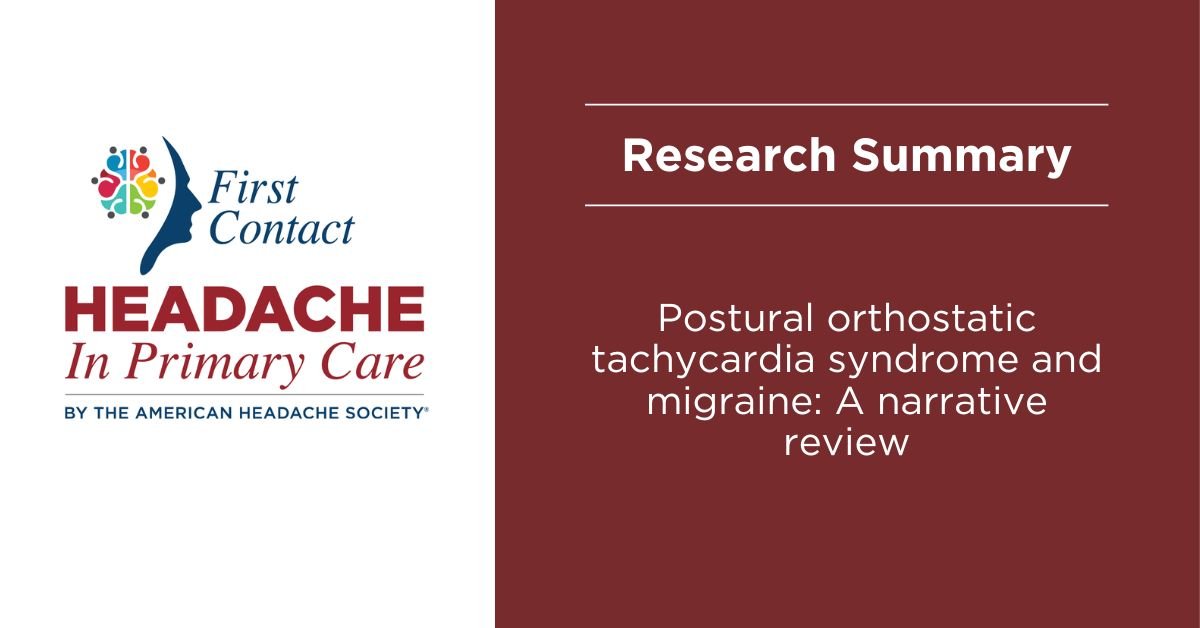
Research Summary: Postural orthostatic tachycardia syndrome (POTS) and migraine: A narrative review
Summarized by Nina Riggins, MD, PhD, FAHS
Patients with postural orthostatic tachycardia syndrome (POTS) commonly experience migraine as a comorbidity. By understanding the underlying mechanisms that may link POTS and migraine, primary care practitioners can find targeted treatments that significantly improve their patients’ quality of life. A recent study reveals three major subtypes of POTS and the pathophysiologic functions that are present in both POTS and migraine.
This month, the First Contact – Headache in Primary Care team summarized Postural orthostatic tachycardia syndrome and migraine: A narrative review.
Study Overview
- Postural orthostatic tachycardia syndrome (POTS) is the most common disorder of the autonomic nervous system.
- Narrative literature review was performed to summarize experimental and clinical evidence demonstrating mechanistic connections between POTS and migraine.
- POTS refers to a positional symptomatic tachycardia, defined by an increase in heart rate of at least 30 beats per minute on assuming an upright position, in the absence of orthostatic hypotension.
- Migraine is the most common comorbidity in patients with POTS.
Study Methods
- PubMed and Medline databases were utilized to perform a literature review and searched for the following keywords: “postural orthostatic tachycardia syndrome,” “POTS,” “autonomic nervous system,” “migraine,” “headache.”
- Articles in English, addressing pathophysiology, treatment, clinical trials, and observational studies, were included and analyzed.
Study Results
- The high prevalence of migraine in patients with POTS may be explained by common pathophysiologic mechanisms, with evidence of dysregulation of the sympathetic nervous system, hemodynamics, and central sensitization, in both POTS and migraine.
- Three major POTS subtypes exist: 1) neuropathic (~ 50% of cases), 2) hypovolemic (~30 %), and 3) hyperadrenergic (~25-50 %).
- Data on neuropathic POTS suggests that partial sympathetic denervation, compensatory hypersensitivity of α-adrenergic receptors, and a vagal neuropathy may contribute to POTS.
- The loss of vagus nerve activity is associated with an increase in pro-inflammatory cytokines and could be reflected in increased prevalence of gastrointestinal symptoms and headache.
- There is evidence that the renin–angiotensin–aldosterone system is dysregulated in hypovolemic POTS. A reduction in intravascular volume leads to a reduction in blood pressure, which is sensed by baroreceptors and leads to an increase in heart rate and blood vessel constriction to maintain blood pressure.
- Hyperadrenergic POTS is characterized by an exaggerated sympathetic response to standing.
- Activation of brain regions involved in regulation of the autonomic nervous system, pain perception, and central sensitization has been demonstrated in patients with POTS and migraine.
- Treatments include cardiovascular exercise and hydration to increase plasma volume.
- Application of external compression and physical maneuvers (e.g., leg crossing, lower extremity muscle squeezing) can be useful.
- There are pharmacologic treatments such as midodrine, the role of which is not established in migraine. Treatments such as beta blockers could be helpful for patients living with migraine and POTS.
- Several small observational studies suggest non-invasive vagus nerve stimulation (nVNS) may decrease orthostatic tachycardia in patients with POTS.
- Migraine treatments that decrease peripheral and central sensitization, including onabotulinumtoxinA and calcitonin-gene-related peptide antagonists, may improve POTS symptoms, but this has not been studied.
Implications for Primary Care Clinicians
- This study shows that the high prevalence of migraine in patients with POTS may be explained by common pathologic mechanisms.
Understanding of shared pathophysiology may provide critical insight into the development of individualized treatment strategies for patients with POTS and migraine.
This summary is part of the First Contact — Headache in Primary Care initiative, an American Headache Society program that provides educational resources to empower healthcare professionals and improve headache and migraine care. We encourage providers in all stages of their careers to visit our homepage to access educational tools to improve patient care.


